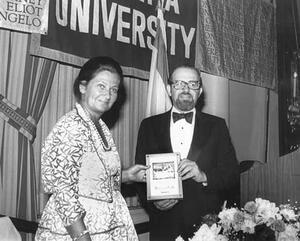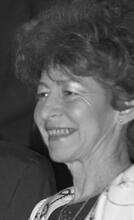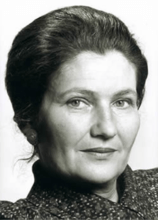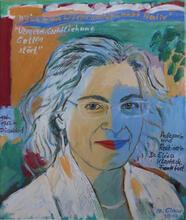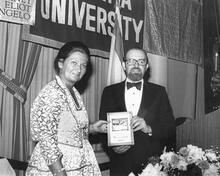Simone Veil
Simone Veil was a survivor of the Holocaust, having been deported with one of her sisters and her mother and interned at Auschwitz-Birkenau and Bergen-Belsen. After the war, she was a pioneer in the French government, penitentiary administration, and judicial system as well as in the European Union. As Minister of Health during Valéry Giscard d’Estaing’s presidency, she presented and successfully argued the law decriminalizing abortion in France. She was the first woman to preside over the European Parliament and was voted into the Académie Française, the sixth woman to join the “Immortals.” Upon her death in 2017, the decision to inter her remains in the Panthéon was made in record time; she is the fifth woman to be interred there.
Advancement of women’s legal rights
Simone Veil is arguably the one person most responsible for advancing women’s legal rights in France during the twentieth and twenty-first centuries. She is certainly the one whose name comes up most often, each time the law that bears her name is mentioned—the law that she proposed and fought for in the French Parliament, the law legalizing abortion that went into effect on January 17, 1975. Today, even if women are not familiar with her numerous accomplishments, they remember her name every time abortion and other contraceptive rights are discussed.
Family background and deportation
Simone Jacob was born in Nice on July 13, 1927, into a Jewish family with origins in the Lorraine area. Her father, André (born in Paris 1890, died in 1944?), earned a degree in architecture from the École des Beaux-Arts in Paris in 1920 . In 1922 he married Yvonne Steinmetz (born in Paris, 1900, died in Bergen-Belsen, 1945), who had earned a high school diploma in science and intended to study chemistry at a university, but then decided to forego a career outside the home. The couple had four children: Madeleine (nicknamed Milou; 1923-1952); Denise (1924-2013); Jean (1925-1944?); and Simone. They moved to Nice in 1924 to take advantage of construction projects on the Côte d’Azur. Simone was educated at the city’s high school and successfully completed her final exit exam on March 28, 1944, two days before her arrest by the Germans. She always feared that taking the test and giving her real name led to the arrest of her family. Veil gave descriptions of the sequence of events that led to their arrest in several vivid and touching interviews with www.franceculture.org and in the book, Dawn at Birkenau (L’aube à Birkenau), (Les Arènes, 2018).
Yvonne, Milou, and Simone were deported to Auschwitz-Birkenau and then to Bergen-Belsen. Only the daughters survived the concentration camps and were liberated on January 27, 1945. Denise, who had entered the French Resistance at the start of the war, was arrested and deported to Ravensbruck as a resistant, not as a Jew. Among the first to be liberated, she reached Paris by May 1, 1945.
André was deported, together with Jean, on May 15, 1944, in Convoy 73, comprised of 878 Jewish males taken from Paris-Bobigny to Reval, Estonia (present-day Tallin), with a stop in Kovno, Lithuania. Of these 878, only seventeen survived. No researchers have been able to determine what happened to André and Jean. One of the saddest details of André’s fate is that he fought in World War I and was a staunch supporter of the French Republic, believing that patriotism and secularity were the most essential factors for progress for France. Simone said that he raised his children to be proud of their nationality above all else; he believed that his fellow countrymen would never capitulate to Nazi demands to deport Jews and that Marshall Pétain, the World War I hero, would protect the French from the Nazis.
Influence of Veil’s mother
In documentaries and interviews, Veil talked about the humiliation and agony of those days, of her mother’s courage, and of her ever-present grief over her mother’s absence. Her mother, who was her major role model, succumbed to typhus in Bergen-Belsen. In her remarks following the screening of a documentary on her life’s work at the 2005 International Women’s Film Festival in Créteil (Simone Veil, a French Story; Simone Veil, une histoire française, directed by David Teboul, 2005), Veil displayed her characteristic charisma as she addressed the audience of various ages and backgrounds. The topic of the session was “What future for feminism and women’s rights in France?” In her speech, Veil first paid tribute to her mother, describing her bravery at all times and especially during the internment in Auschwitz. When Veil was asked how she found the stamina to withstand the onslaught of vitriolic attacks during the debate on abortion, she always repeated that she owed it all to her mother. Even at that Créteil discussion, some 60 years after Yvonne’s death, Veil explained that her mother remained present in her mind, with her: “I’m often asked what gave me the strength and will to continue the fight. I believe deeply that it was my mother; she has never stopped being present to me, next to me” (author’s translation from Veil’s remarks made at the 2005 Créteil event).
Veil’s life after liberation from the camps and her return to Paris
Milou’s sudden death in an automobile accident in 1952 was a powerful blow to Simone because she lost the person who perhaps understood her best and supported her the most. They had suffered through, and survived, Auschwitz-Birkenau and Bergen-Belsen together, then struggled through the unexpectedly difficult re-entry into French society, learning painfully that people wanted to talk about the heroism of the Resistant but skittishly avoided discussions of the horrors that the Jewish people had suffered.
Returning to studies after the war, Simone earned a degree in law and political science, then took the extremely competitive national magistrate exam and passed in 1956. In October 1946, she married Antoine Veil (born in Blâmont in 1926, died in Paris in 2013) who completed the prestigious National School of Administration, the school that prepares students for France’s highest political positions. After a successful career in public administration, he moved to private enterprise. The Veils had three sons: Jean (born in 1947), Nicolas (1948-2002), and Pierre-François (born in 1954).
The “Veil Law” debate: antisemitic remarks and attacks
Even with her mother’s memory and her family’s support (as well as that of then President Valéry Giscard d’Estaing, who had just appointed her as Minister of Health), the days during the abortion debate in 1974 were immeasurably difficult. Much of the aggression was aimed personally at Veil and her family and smacked of antisemitism; it came from all sides, from members of the Parliament on the floor to anonymous letters to her office and her home. The most abhorrent remarks even compared the legalization of abortion to the Holocaust. The anonymous attacks included swastikas painted on her car and the elevator in her building and letters condemning her children to hell. At about the same time, Parliament also voted to ban laboratory experiments on animals for commercial purposes; during debate on that issue, certain members openly likened what they called the genocide of animals to the “genocide” of babies and to the genocide of Auschwitz. The worst comment she remembered from the time was one made by Jean-Marie Daillet, a member of Parliament, who asked if she would agree to the idea of throwing embryos into crematorium ovens. However, at the same time, and in the years afterward, many others paid tribute to her, approaching her even in the street to thank her and tell her she would never be forgotten for all she had done. During her comments at the Créteil discussion in 2005, she cited an example of a man who came up to her in a store near her home and said that “her” law also meant great progress for men.
Veil’s other contributions to French society and citizen’s rights
As crucial as the “Veil Law” is, it would be a mistake to overlook Veil’s other contributions to French society, particularly for those with no other champions for their cause. From 1946 to 1974, she held various positions through which she was able to further women’s rights. For example, from 1957 to 1964, when she was the National Penitentiary Administrator under the Ministry of Justice, she discovered that, although the number of women prisoners was far lower than number of men prisoners and that they presented no significant discipline problems, the conditions of their incarceration were far more repressive. So, during her tenure in that position, she worked to improve their treatment and succeeded in regrouping Algerian women prisoners together and enabling them to pursue education. In 1964, she became the Director of Civil Affairs, a position that enabled her to have a direct impact on French women’s general rights and status. Among her achievements in this post were dual parental control of family legal matters, rights for single mothers and their children in cases where the father is unidentified, and adoption rights for women. Next, at the Ministry of Health (1975 to 1979), she fought to end various forms of discrimination against women. Besides the highly visible Veil Law, she strove in other ways to help women care for their families; for example, she was able to expand health coverage, monthly stipends for childcare, maternity benefits, etc.
Veil as pioneer in France and the European Union
Having been only the second female minister in the French government, Veil followed with a number of other pioneering positions in France and the European Union. She left the ministry of health in 1979 to run in the first direct-suffrage European parliamentary elections and became the first woman president of the European Parliament (with a set term of three years: 1979-1982). She was elected to the parliament for further terms: as representative in 1984 and 1989 and served also as its deputy president. From 1993 to 1995, she returned to the French government as under-secretary of Social Affairs, Health and Urban Issues. From 1997 to 1998 she was president of the High Council for Integration. In March 1998, she was named to the Constitutional Counsel (Conseil Constitutionnel, the highest legal authority in France) and served until her term expired in 2007. In November 2008, Veil was elected to the French Academy (Académie Française), only the sixth woman to join the “Immortals.” In 2012, she was awarded the Grand Cross of the Legion of Honor (Grande Croix de la Légion d’Honneur). In thinking back upon her career, Veil underscored the personal symbolic aspect of having been first at so many things; in particular, she mentioned the importance of a Holocaust survivor presiding over the European Parliament.
Selective list of honors bestowed upon Veil
Along with her professional positions and accomplishments, Veil was active in various groups and received high honors for her dedication. She was the president of the Foundation for the Memory of the Shoah and honorary president of the Foundation of Science and Culture in Europe. She received awards from the Klein Foundation (Philadelphia, 1991), The Truman Award for Peace (Jerusalem, 1991), the Giulietta Award (Verona, 1991), the Atlantida Award (Barcelona, 1991), the Gold Medal from the Stresemann Association (Mayence, 1993), the Obiettivo Europa Award (Milan, 1993), the Henrietta Szold Award (Miami, 1996), and the Gold Medal for furthering the Health of All Peoples from the World Health Organization (1997). She was appointed both Chevalier de l’Ordre National du Mérite and Grand Officer of the Order of the British Empire (OBE). Among the numerous universities that awarded her an honorary degree are Princeton (1975), the Weizmann Institute (1976), Bar Ilan University (1980), Cambridge (1980), Yale (1980), Georgetown (1981), Yeshiva University (1982), the Hebrew University of Jerusalem (1986), Brandeis (1989), and the University of Pennsylvania (1997).
Veil as feminist activist?
When asked if she was a feminist, Veil said she did not consider herself a militant per se, mainly because she weighed all sides of an issue before acting, whereas militancy requires serving a cause while glossing over its inconsistencies (author’s translation from her remarks at Créteil in 2005). But she did feel like a feminist in the sense of solidarity with women; she felt closer to women and influenced by them. Also, she felt more at ease with women, perhaps due to her internment. In the camps, she said, women helped each other in a generous, unselfish way, which was not the case with men. And, she added, the capacity for resistance of the so-called weaker sex was much greater (See Veil, Men Remember too. A Law for History; Les hommes aussi s’en souviennent. Une loi pour l’histoire; Stock, 2004.) Veil’s own capacity for resistance helped her survive the camps; her unselfish desire to help others brought better conditions for women and others who suffered persecution or disenfranchisement. The extent of her contributions inspires awe, especially given the obstacles she encountered and overcame, and she was remarkable for the openness, modesty, and humility with which she fielded questions and pondered the future of women in France, in Europe, and in the world.
Death, homage, and a place in the Panthéon
Veil passed away on June 30, 2017; a national homage took place at the Invalides on July 5, 2017. The decision was made to transfer her from the Montparnasse cemetery to the Panthéon—the fastest decision to admit someone into the Panthéon after their passing on record. She is only the fifth woman to enter into the Panthéon for her merits and the first person from the Fifth Republic. (See interviews and tributes on www.franceCulture.org.)
Veil was transferred to the Panthéon on July 1, 2018, where she joined such greats as Marie Curie, Alexandre Dumas, Victor Hugo, Jean-Jacques Rousseau, and Emile Zola, to name only a few of the 77 at rest there. The procession to the Panthéon began at the Memorial to the Shoah and stopped three times to commemorate her impact in three areas: women’s rights, including the Veil Law that legalized abortions; the European Union, for which she was the first woman to preside over the Parliament; and the memory of the Shoah, of which she was a survivor. After a day of honor in the main entrance to the Panthéon, she was placed in the same part of the crypt as other great defenders of liberty (Jean Moulin, André Malraux, René Cassin and Jean Monnet).
Selected Works by Simone Veil
L’aube à Birkenau. Récit recueilli par David Teboul. Paris: Les Arènes, 2019.
Touching texts and remembrances accompanied by explanations and descriptions furnished by Veil’s longtime friend and documentarian of her stories, David Teboul.
Une vie. Paris: Stock, 2007 ; translated into English as A Life. London : Haus Publishing, 2009.
Veil’s autobiography that answers many questions regarding her sources of inspiration and drive that helped her continue in the face of opposition.
Les hommes aussi s’en souviennent. Une loi pour l’Histoire. Paris: Stock, 2004.
Her speech to Parliament on 26 November 1974, followed by an interview with Le Monde journalist Annick Cojean.
Adler, Laure. Les Femmes politiques. Paris: Seuil, 1993.
An entry on Veil with some pertinent remarks and important quotes from Veil concerning antisemitism and misogyny that she encountered. On the cover is the famous photograph of Veil with her head in her hands, exhausted and exasperated by the debate in the French Parliament in November 1974.
Sauvard, Jocelyne. Simone Veil, la force de la conviction. Paris: Archipel, 2012.
Szafran, Maurice. Simone Veil. Destin. Paris: J’ai lu, 1996.
Films concerning Simone Veil:
La Loi telefilm. Christian Faure, dir. 2014
Un siècle au féminin, portrait de Simone Veil; de Giselle Halimi; de Benôite Groult. Laure Poinsot, dir. 2002. (Each segment, 16 min.)
Simone Veil, une histoire française. David Teboul, dir. 2005.
Other sources regarding Veil:
Interviews and texts for smartphone or tablet.
Documents recorded in the course of an entire night on June 17, 2018, at the Birkenau Camp.
L’aube à Birkenau (Dawn at Birkenau) (1 hour)
La nuit à Birkenau (Night at Birkenau) (1 hour 50 minutes)
http://laubeabirkenau.arenes.fr/

